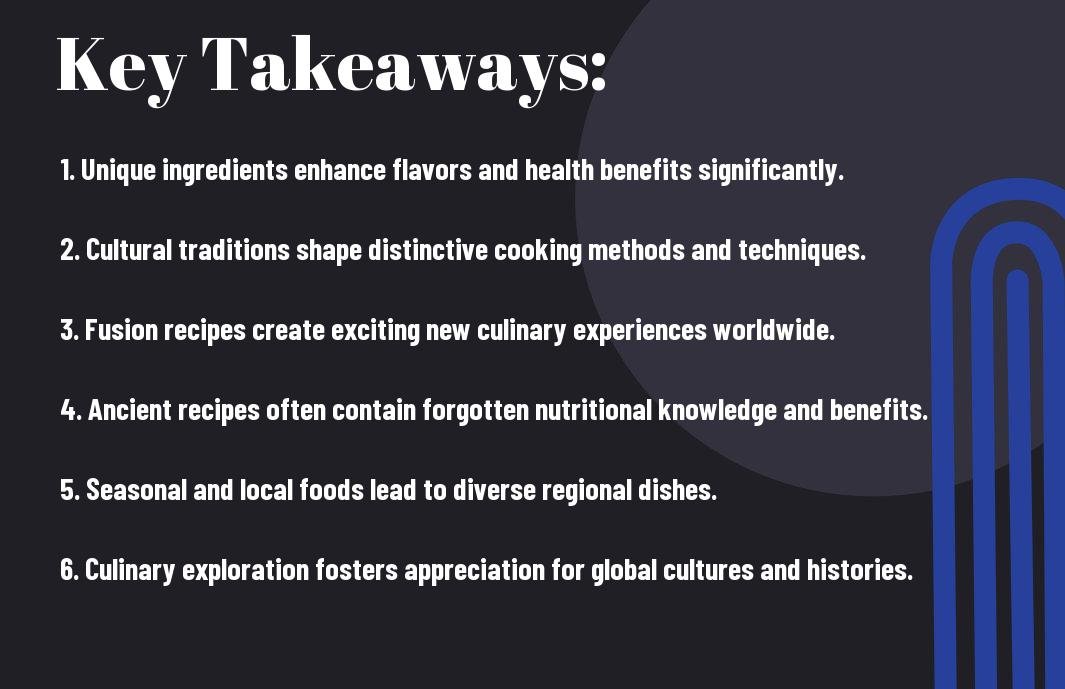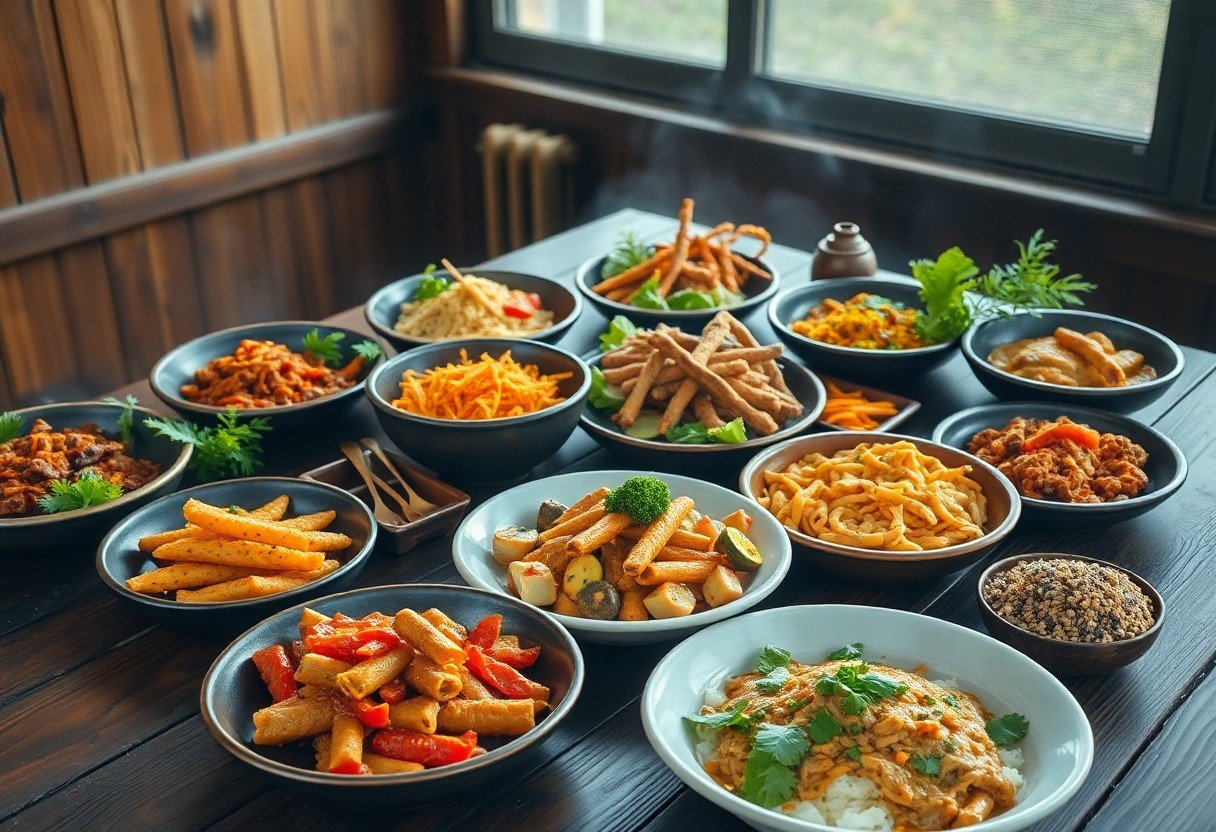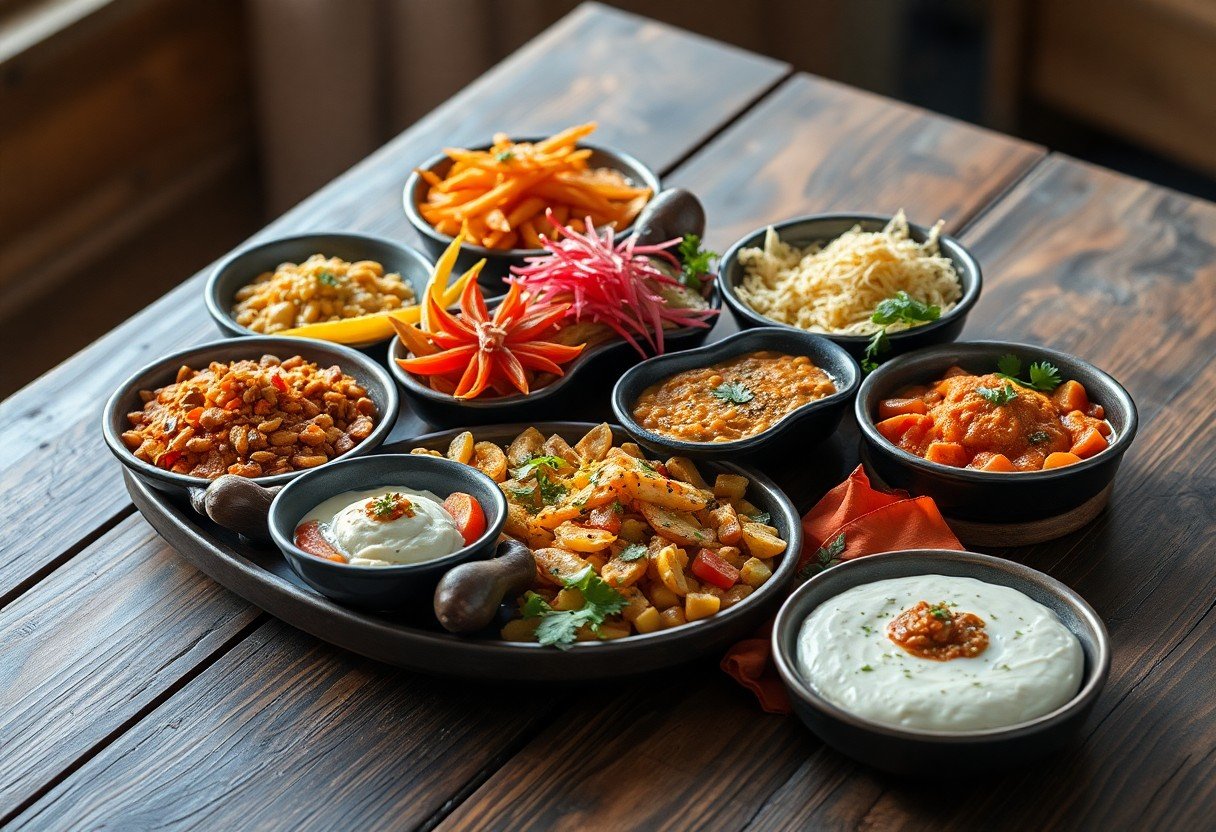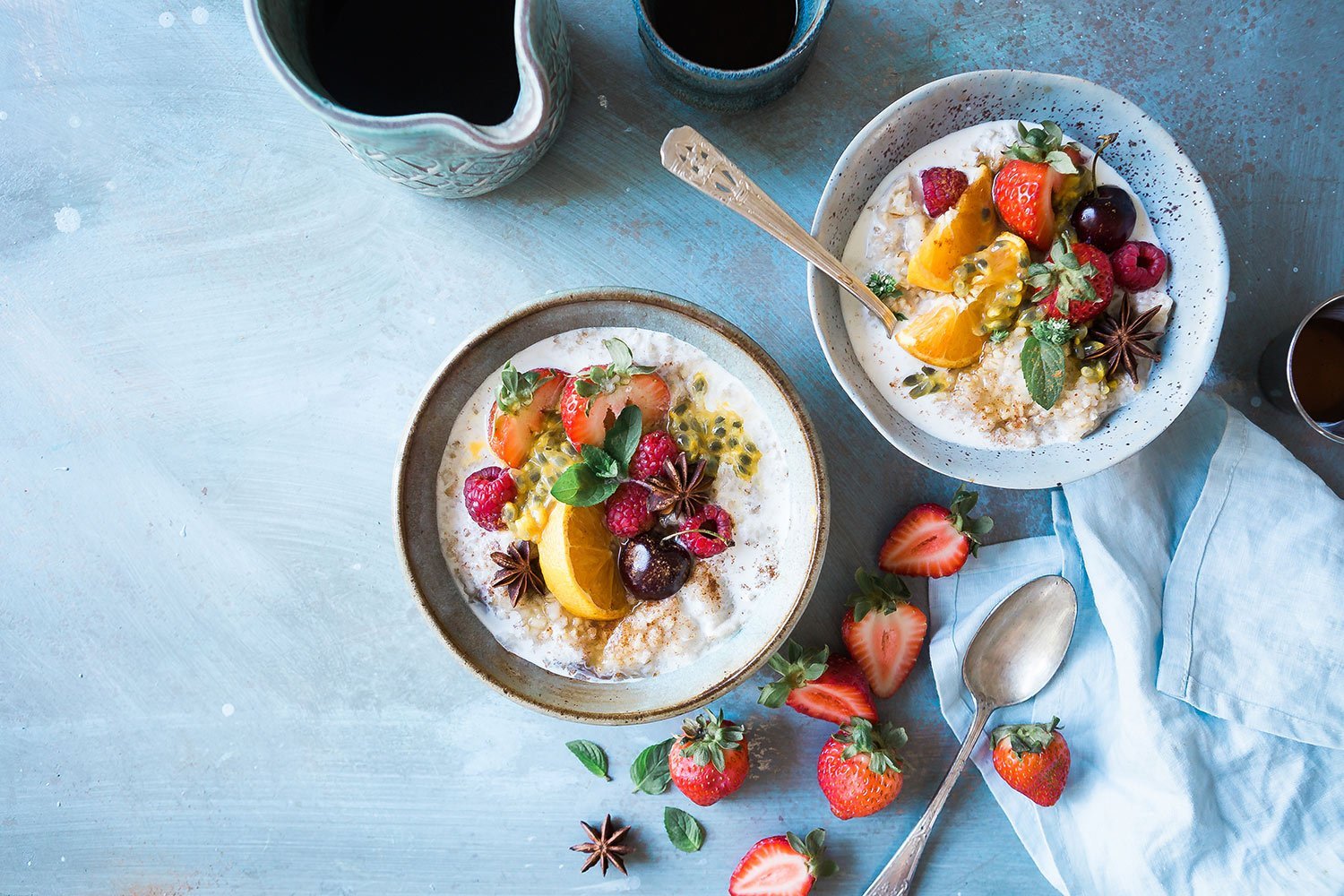Most people tend to overlook the rich traditions and unique flavors hidden within unusual food recipes from diverse cultures. As you explore these culinary gems, you may uncover nutritional benefits and cooking techniques that can elevate your own kitchen repertoire. Whether it’s a lesser-known spice that packs a punch or a time-honored cooking method, these recipes hold the potential to transform your meals into something extraordinary. Join us as we research into these hidden treasures and discover how global flavors can enhance your culinary experiences.

The Allure of Unusual Ingredients
The allure of unusual ingredients lies in their ability to surprise and delight your palate. These rare finds can transform everyday meals into extraordinary culinary experiences. In fact, as you explore People Share The Most Unique, Underrated Global Dishes, you’ll discover flavors and textures you never thought possible, elevating your cooking and meal enjoyment to new heights.
Exploring Global Cuisines
Among the diverse array of global cuisines, you will encounter ingredients that challenge your culinary norms and inspire creativity in the kitchen. These unique components not only add distinctive flavors but also tell stories of the cultures they originate from, enriching your food journey.
Cultural Significance of Rare Ingredients
To fully appreciate unusual food recipes, you must probe into the cultural significance of rare ingredients. These components often embody traditions, celebrations, and local heritage, offering a deeper connection to the communities that cultivate them.
Hence, embracing these ingredients can transform your cooking practices and enhance your understanding of global cuisines. For instance, certain items are harvested during specific seasons or festivals, highlighting their cultural importance. Additionally, some ingredients are considered medicinal or protective, contributing to your health. By integrating these elements into your meals, you deepen your appreciation for diversity and foster connections with cultures around the world.
Hidden Health Benefits
There’s a wealth of hidden health benefits waiting to be uncovered in unusual food recipes from around the globe. Many of these unique dishes incorporate ingredients that boast impressive nutritional profiles, enhancing your well-being while heightening your culinary experience.
Nutritional Value of Uncommon Foods
At the heart of many unusual recipes lies the incredible nutritional value of uncommon foods. Ingredients such as quinoa, amaranth, and insects are often rich in protein, fiber, vitamins, and minerals, far surpassing conventional staples. By exploring these dishes, you can diversify your diet and enjoy numerous health benefits.
Medicinal Properties in Traditional Recipes
Medicinal properties found in traditional recipes can significantly impact your health and wellness. These recipes often utilize herbs, spices, and other natural ingredients known for their anti-inflammatory, antioxidant, and antimicrobial properties. The combination of flavors not only tantalizes your taste buds but also offers a holistic approach to health, aiding in digestion, boosting immunity, and enhancing mental clarity.
The fascinating aspect of traditional recipes is their holistic approach to health—many cultures have wielded the power of food as medicine for generations. For example, ingredients like ginger and turmeric are renowned for their strong anti-inflammatory effects, while others, such as garlic, can help in strengthening your immune system. By incorporating these traditional remedies into your meals, you embrace a natural way to support your health and well-being effectively.

Cooking Techniques from Around the World
To explore the rich tapestry of global cuisines, it is necessary to understand the diverse cooking techniques that define them. From traditional methods like steaming in bamboo baskets to the unique use of clay pots for slow cooking, each technique carries cultural significance and contributes to the unique flavor profiles of the dishes. By incorporating these varied techniques into your own cooking, you can not only enhance your meals but also pay homage to culinary traditions from different parts of the world.
Unique Methods That Enhance Flavor
Across the globe, chefs and home cooks alike employ distinctive methods designed to elevate the natural flavors of their ingredients. Techniques such as sous-vide cooking, which uses precise temperature control, or the practice of dry-aging meats to develop depth, showcase how culinary innovation can enhance taste. By adopting these unique methods in your kitchen, you can bring a new dimension to your dishes that will delight your palate and impress others.
Preservation Techniques with Culinary Impact
After exploring flavor-enhancing methods, it’s important to consider how preservation techniques play a vital role in global cooking practices. Techniques like fermentation and pickling not only prolong shelf life but also add distinctive flavors and health benefits to your meals. You can discover a world of taste variations in ingredients that are preserved using these traditional methods, transforming simple items into gourmet delights.
Consequently, engaging with preservation techniques can profoundly affect your culinary experience. By utilizing methods such as fermentation, you can create gut-friendly dishes that celebrate live cultures, while techniques like pickling allow you to enjoy seasonal produce all year round. Additionally, be cautious when experimenting with preservation, as improper methods can result in foodborne illnesses. When done correctly, these time-honored practices enhance flavors and add considerable nutritional value to your meals, yielding both taste and health benefits that enrich your culinary repertoire.
The Role of Heritage in Recipes
Unlike many modern dishes that prioritize convenience, heritage recipes often tell stories passed through generations. They encapsulate cultural identities and are a testament to the evolution of culinary practices. You can explore what are some ‘forgotten’ dishes and recipes that few…, revealing flavors and techniques that may have otherwise been lost to time.
Family Traditions and Oral Histories
Between family gatherings and intimate celebrations, food often serves as a link to our ancestors. The dishes you prepare may include ingredients and methods passed down through stories, preserving your cultural heritage while fostering a sense of belonging among family members. Such recipes help you connect with your roots and cherish timeless traditions.
Regional Variations and Adaptations
Role variations across regions ensure that recipes are adapted to local ingredients and cultural practices. These adaptations not only enhance flavors but also provide a rich tapestry of culinary experiences. Your ingredients may vary significantly depending on where you are, used to create dishes that resonate with local taste preferences while staying true to the essence of the original recipe.
To maximize your culinary journey, seek out the regional variations of your favorite dishes. By incorporating local ingredients, you may discover unique flavor profiles and cooking techniques that celebrate the history of a place. Be aware that some recipes may contain allergens or strong flavors unfamiliar to your palate, so proceed with enthusiasm, and keep an open mind as you explore!

Merging Flavors: Fusion Cuisine
Once again, the culinary world surprises you with its ability to blend various traditions into vibrant, innovative dishes. Fusion cuisine takes the essence of one culture’s flavors and melds them with another, creating unique gastronomic experiences that fire your imagination. By allowing different culinary heritages to collide, you open yourself to a delightful spectrum of taste and texture. From Mexican-Asian tacos to Italian sushi rolls, fusion cuisine illustrates how food can transcend borders and result in unexpected treasures.
Innovative Combinations of Diverse Ingredients
Ingredients from different cultures mingle harmoniously in fusion cuisine, taking your palate on an adventurous journey. By combining unexpected elements—think sweet pineapple in savory barbecue or spicy kimchi in classic grilled cheese—you create mouthwatering dishes that surprise and delight. This culinary creativity invites you to explore flavors and textures you might have never experienced before, enhancing your stash of home cooking ideas.
The Impact of Globalization on Culinary Arts
Combinations of diverse ingredients have flourished with the rise of globalization, allowing you to access cuisines you previously only dreamed of tasting. As food culture becomes increasingly interconnected, you benefit from a wider range of flavors and techniques that enrich your culinary arsenal. At the same time, this expansion poses challenges, such as the potential for diluted culinary traditions and loss of authenticity as certain dishes become overly commercialized. You can, however, appreciate the learning opportunities globalization offers while remaining mindful of the roots from which these flavors originate.
To truly embrace the positive impact of globalization on culinary arts, you should celebrate the cultural richness behind each dish. By venturing into fusion cuisine, you discover that the blending of flavors can enhance your home cooking, making it both exciting and reflective of a global heritage. Take the time to learn about the origins of ingredients and techniques; this understanding can deepen your appreciation for the dishes you create. Ultimately, this journey allows you to savor not just the meals on your plate, but the diverse culinary stories they tell.
Sustainability and Ethical Eating
All around the world, food culture increasingly emphasizes the importance of sustainability and ethical eating. By exploring unusual recipes, you can discover not only delicious flavors but also ways to minimize your ecological footprint. By sourcing ingredients with an eye toward ethical practices, you contribute to a healthier planet while preserving traditional culinary methods that respect the environment.
Sourcing Local and Unusual Ingredients
Ingredients sourced locally often boast superior flavor and freshness, which can elevate your dishes. When you seek out unusual ingredients from nearby farmers’ markets or specialty shops, you support local economies and promote biodiversity. This practice not only reduces the carbon footprint associated with transportation but also invites you to experiment with flavors that may be unfamiliar and exciting.
Reducing Food Waste Through Creative Recipes
Below the surface of traditional cooking, there are endless possibilities to minimize food waste through creativity. You can utilize parts of ingredients you typically discard, such as stems, leaves, and skins, to create nourishing meals. This approach not only improves your culinary skills but also empowers you to make a positive impact on global food waste.
Hence, by embracing creative recipes that utilize every part of your ingredients, you not only prevent food waste but also enhance the nutritional value of your meals. Experimenting with leftover vegetables or stale bread can lead to delightful dishes, turning potential waste into delicious flavors. This practice not only conserves valuable resources but also encourages you to appreciate the full spectrum of culinary possibilities that sustainability offers. So, tap into your creativity and transform your cooking routine into a more conscious, ethical adventure.
Summing up
Drawing together the myriad flavors, techniques, and traditions encapsulated in unusual food recipes from around the globe reveals a wealth of hidden treasures waiting for your discovery. By exploring these unique culinary creations, you not only enhance your personal cooking skills but also deepen your understanding of diverse cultures and histories. Embracing these unconventional dishes can transform your dining experience, inviting creativity and excitement into your kitchen. So go ahead, experiment with global recipes, and unearth the culinary gems that define the rich tapestry of world cuisine.









